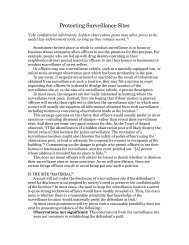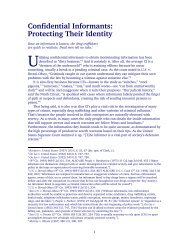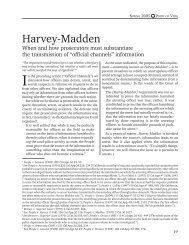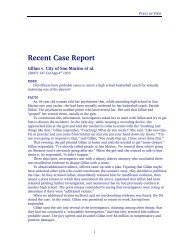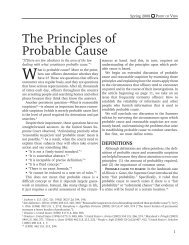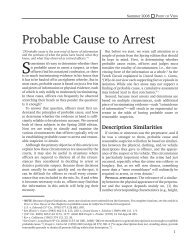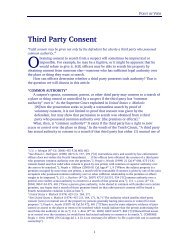Executing Search Warrants - Alameda County District Attorney's Office
Executing Search Warrants - Alameda County District Attorney's Office
Executing Search Warrants - Alameda County District Attorney's Office
You also want an ePaper? Increase the reach of your titles
YUMPU automatically turns print PDFs into web optimized ePapers that Google loves.
RESIDENTS: All residents may be detained pending completion of the search. 42<br />
VISITORS: All visitors may be briefly detained to determine their connection to the<br />
premises. 43 If it turns out they are not residents and are not involved in the illegal<br />
activity under investigation, they must be released. In determining the visitor’s<br />
status, officers may rely on direct and circumstantial evidence. For example, it may<br />
be reasonable to believe a visitor was a criminal associate if he ran or made a furtive<br />
gesture when he saw the officers; or, while the search was underway, he entered the<br />
house without knocking or announcing his presence. 44<br />
ARRIVALS: <strong>Office</strong>rs may briefly detain people who arrive outside the residence at or<br />
about the same time as they did, and whose identity and connection to the premises<br />
are unknown and cannot be immediately determined. 45 The purpose of the detention<br />
is to find out if the person is a detainable occupant or an uninvolved visitor. 46<br />
DETAINING OCCUPANTS OF A BUSINESS: <strong>Office</strong>rs who are searching a business open<br />
to the public may detain a person on or near the premises only if there is reasonable<br />
suspicion that the person is connected with the illegal activities under investigation. 47<br />
of the law execute a valid warrant to search his home.”]; People v. Ingram (1993) 16 Cal.App.4 th<br />
1745, 1751-2; People v. Gabriel (1986) 188 Cal.App.3d 1261, 1264-5.<br />
42 See Michigan v. Summers (1981) 452 US 692, 705 [“(A) warrant to search for contraband<br />
founded on probable cause implicitly carries with it the limited authority to detain the occupants<br />
of the premises while a proper search is conducted.”]; People v. Glaser (1995) 11 Cal.4th 354, 373<br />
[“(A) resident or intimate of the home, who may have criminal interests there to protect, may<br />
present a substantial risk . . . ”]; People v. Thurman (1989) 209 Cal.App.3d 817, 823; People v.<br />
Gabriel (1986) 188 Cal.App.3d 1261, 1264. ALSO SEE People v. Ingram (1993) 16 Cal.App.4th<br />
1745, 1751-2.<br />
43 See People v. Glaser (1995) 11 Cal.4 th 354, 374-5.<br />
44 See People v. Huerta (1990) 218 Cal.App.3d 744, 749 [“When defendant entered the residence<br />
without knocking or announcing his presence the officers executing the warrant had reason to<br />
believe defendant was directly connected to the premises in some way.”]; People v. Fay (1986)<br />
184 Cal.App.3d 882, 892-3 [“Once Totah had entered the apartment building and was seen<br />
standing in front of the apartment about to insert keys into the lock, the officers had reasonable<br />
grounds to believe that he was a resident of the apartment”]; People v. Glaser (1995) 11 Cal.4th<br />
354, 365 [defendant “appeared to be more than a stranger or casual visitor”]; People v. Valdez<br />
(1987) 196 Cal.App.3d 799, 802-4 [although defendant’s connection to the premises was<br />
unknown, he and another man who were standing close together “started turning away from<br />
officers” when the officers identified themselves]; People v. Samples (1996) 48 Cal.App.4th 1197,<br />
1206 [“(A)ppellant was clearly in close association with several subjects of a search warrant which<br />
was then being executed.”]; People v. Tenney (1972) 25 Cal.App.3d 16, 26-7 [defendant opened<br />
the door without knocking and ran when he saw the officers inside]; U.S. v. Fountain (6th Cir.<br />
1993) 2 F.3d 656, 663 [the concerns that justify the detention of people inside a house being<br />
searched for drugs “are the same regardless of whether the individuals present in the home being<br />
searched are residents or visitors.”]; Burchett v. Kiefer (6th Cir. 2002) 310 F.3d 937, 943 [“(T)he<br />
Supreme Court’s discussion of ‘occupants’ in Summers included nonresidents who are present at<br />
the scene of a search when police arrive”; suspect approached the house, saw the officers, and<br />
fled]. PROSECUTOR’S NOTE: Defense attorneys may cite People v. Gallant (1990) 225<br />
Cal.App.3d 200 in visitor-detention cases. Gallant has been implicitly overruled by Glaser. See<br />
People v. Samples (1996) 48 Cal.App.4th 1197, 1206.<br />
45 See People v. Glaser (1995) 11 Cal.4 th 354, 374.<br />
46 See People v. Glaser (1995) 11 Cal.4 th 354, 366, 374.<br />
47 See People v. Ingram (1993) 16 Cal.App.4 th 1745, 1752-3 [“(W)hen executing a search warrant at<br />
a business open to the public, law enforcement officers may detain those persons on the premises<br />
when the circumstances create a reasonable suspicion of a relationship between the person and<br />
the place sufficient to connect the individual to the illegal activities giving rise to the warrant.”].<br />
8



